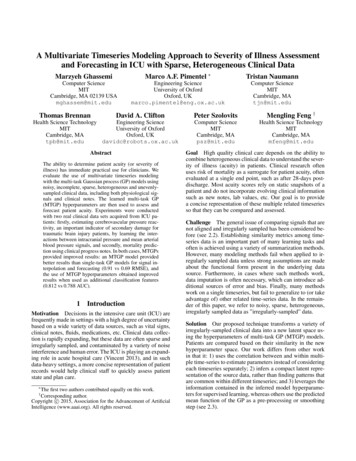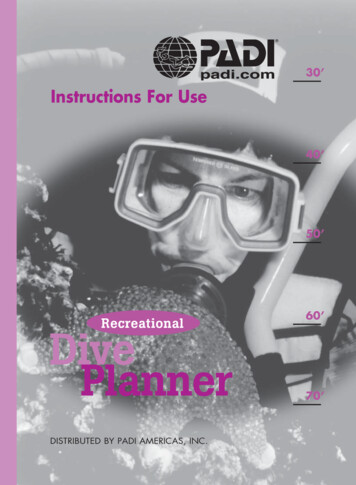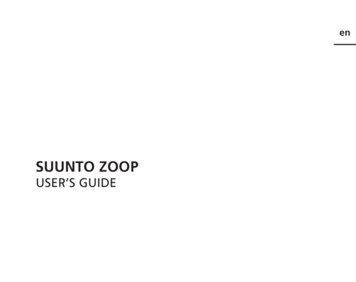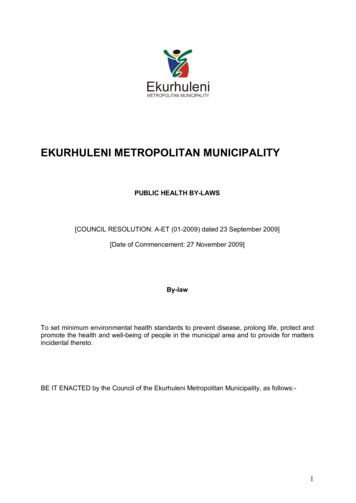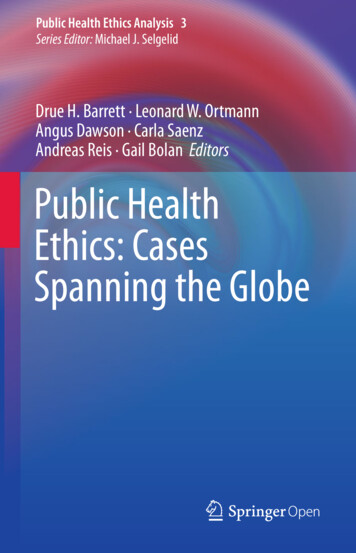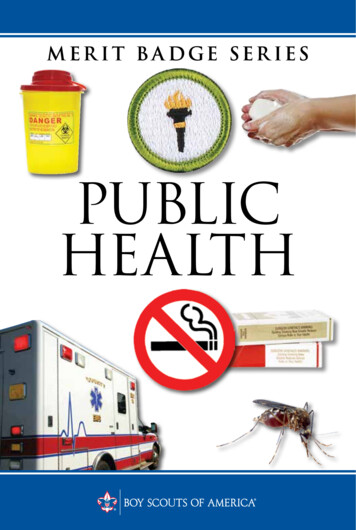
Transcription
PUBLICHEALTH
BOY SCOUTS OF AMERICAMERIT BADGE SERIESPUBLIC HEALTH“Enhancing our youths’ competitive edge through merit badges”
Public Health1. Do the following:(a) Explain what public health is. Explain how Escherichia coli (E. coli),tetanus, HIV/AIDS, malaria, salmonellosis, and Lyme disease are contracted.(b) Choose any FOUR of the following diseases or conditions, and explainhow each one is contracted and possibly prevented: gonorrhea, West Nilevirus, Zika, botulism, influenza, syphilis, hepatitis, emphysema, meningitis,herpes, lead poisoning.(c) For each disease or condition in requirement 1b, explain:(i) The type or form of the malady (viral, bacterial, environmental, toxin)(ii) Any possible vectors for transmission(iii) Ways to help prevent exposure or the spread of infection(iv) Available treatments2. Do the following:(a) Explain the meaning of immunization.(b) Name eight diseases against which a young child should be immunized,two diseases against which everyone should be reimmunized periodically,and one immunization everyone should receive annually.(c) Using the list of diseases and conditions in requirement 1b, discuss withyour counselor those which currently have no immunization available.3. Discuss the importance of safe drinking water in terms of the spread ofdisease. Then, demonstrate two ways for making water safe to drink thatcan be used while at camp. In your demonstration, explain how dishes andutensils should be washed, dried, and kept sanitary at home and in camp.4. Explain what a vector is and how insects and rodents can be controlled inyour home, in your community, and at camp. Tell why this is important. Inyour discussion, explain which vectors can be easily controlled by individualsand which ones require long-term, collective action.5. With your parent’s and counselor’s approval, do ONE of the following:(a) Visit a municipal wastewater treatment facility OR a solid-waste managementoperation in your community.(i) Describe how the facility safely treats and disposes of sewage orsolid waste.(ii) Discuss your visit and what you learned with your counselor.(iii) Describe how sewage and solid waste should be disposed of underwilderness camping conditions.
(b) Visit a food service facility, such as a restaurant or school cafeteria.(i) Observe food preparation, handling, and storage. Learn how the facility keeps food from becoming contaminated.(ii) Find out what conditions allow micro-organisms to multiply in food,what can be done to help prevent them from growing and spreading, andhow to kill them.(iii) Discuss the importance of using a thermometer to checkfood temperatures.(iv) Discuss your visit and what you learned with your counselor.6. Do the following:(a) Describe the health dangers from air, water, and noise pollution.(b) Describe health dangers from tobacco use and alcohol and drug abuse.(c) Describe the health dangers from abusing illegal and prescription drugs.7. With your parent’s and counselor’s approval, do ONE of the following:(a) Visit your city, county, or state public health agency.(b) Familiarize yourself with your city, county, or state health agency’s website.After completing either 7a or 7b, do the following:(i) Compare the four leading causes of mortality (death) in your communityfor any of the past five years with the four leading causes of disease in yourcommunity. Explain how the public health agency you visited is trying toreduce the mortality and morbidity rates of these leading causes of illnessand death.(ii) Explain the role of your health agency as it relates to the outbreakof diseases.(iii) Discuss the kinds of public assistance the agency is able to provide incase of disasters such as floods, storms, tornadoes, earthquakes, and otheracts of destruction. Your discussion can include the cleanup necessaryafter the disaster.8. Pick a profession in the public health sector that interests you. Find out theeducation, training, and experience required to work in this profession.Discuss what you learn with your counselor.
Resources.ResourcesScouting LiteratureBoy Scout Handbook; Fieldbook; AnimalScience, Camping, Citizenship in theCommunity, Citizenship in the Nation,Citizenship in the World, Cooking,Dentistry, Emergency Preparedness,Environmental Science, First Aid,Medicine, Safety, Search and Rescue,and Soil and Water Conservation meritbadge pamphletsFor more information aboutScouting-related resources, visitthe BSA’s online retail catalog(with your parent’s permission)at http://www.scoutstuff.org.BooksBock, Kenneth, and Cameron Stauth.Healing the New ChildhoodEpidemics: Autism, ADHD,Asthma, and Allergies. BallantineBooks, 2008.Drisdelle, Rosemary. Parasites: Talesof Humanity’s Most UnwelcomeGuests. University of CaliforniaPress, 2011.78 PUBLIC HEALTHDunn, Rob. The Wild Life of OurBodies: Predators, Parasites, andPartners That Shape Who We AreToday. Harper, 2011.Foege, William. House on Fire: TheFight to Eradicate Smallpox.University of California Press, 2012.Friedlander, Mark P. Outbreak: DiseaseDetectives at Work. Twenty-FirstCentury Books, 2009.Human Kinetics. Health and Wellnessfor Life. Human Kinetics, 2009.Pendergrast, Mark. Inside theOutbreaks: The Elite MedicalDetectives of the EpidemicIntelligence Service. HoughtonMifflin Harcourt, 2010.Rhodes, John. The End of Plagues:The Global Battle AgainstInfectious Disease. PalgraveMacMillan Trade, 2013.Seltzer, Beth. 101 Careers in PublicHealth. Springer PublishingCompany, 2010.Sherman, Irwin. Twelve DiseasesThat Changed Our World. ASMPress, 2007.
.ResourcesThornton, Denise. Living With Cancer:The Ultimate Teen Guide. ScarecrowPress, 2011.Youngdahl, Karie, et al. The History ofVaccines. College of Physicians ofPhiladelphia, 2013.Organizations and WebsitesBureau of Health WorkforceHealth Resources andServices AdministrationToll-free telephone: 888-275-4772Website: http://www.hrsa.govCenters for Disease Controland Prevention1600 Clifton RoadAtlanta, GA 30333Toll-free telephone: 800-232-4636Website: http://www.cdc.govEnvironmental Protection AgencyWilliam Jefferson ClintonFederal Building1200 Pennsylvania Ave. NWWashington, DC 20460Telephone: 202-272-0167Website: http://www.epa.govNational Institutes of HealthTelephone: 301-496-4000Website: http://www.nih.govOffice of Disease Prevention andHealth PromotionTelephone: 240-453-8280Website: http://www.odphp.osophs.dhhs.govU.S. Department of Health andHuman ServicesToll-free telephone: 877-696-6775Website: http://www.hhs.govU.S. Food and Drug Administration10903 New Hampshire Ave.Silver Spring, MD 20993Toll-free telephone: 888-463-6332Website: http://www.fda.govU.S. Public Health ServiceCommissioned CorpsToll-free telephone: 800-279-1605Website: http://www.usphs.govWorld Health OrganizationWebsite: http://www.who.intAcknowledgmentsThe Boy Scouts of America isthankful to Dr. William C. Reeves forhis help in updating the 2014 printingof the Public Health merit badge pamphlet. The BSA also thanks the following subject experts for their assistancewith updating the 2005 edition: Eric J.Pyle, Ph.D., Depart ment of EducationTheory and Practice, West VirginiaUniversity; Gerald F. Pyle, Ph.D.,Department of Health Promotionsand Kinesiology, University of NorthCarolina–Charlotte; and Richard W.Klomp, Information ManagementTeam, Centers for Disease Controland Prevention.Thanks to the Centers for DiseaseControl and Prevention, Atlanta,Georgia, for providing the information found in the “RecommendedImmunization Schedule.”The Boy Scouts of America isgrateful to the men and women serving on the Merit Badge MaintenanceTask Force for the improvements madein updating this pamphlet.PUBLIC HEALTH 79
of the Public Health merit badge pam-phlet. The BSA also thanks the follow-ing subject experts for their assistance with updating the 2005 edition: Eric J. Pyle, Ph.D., Department of Education Theory and Practice, West Virginia University; Gerald F. Pyle, Ph.D., Department of Health Promotions and Kinesiology, University of North

